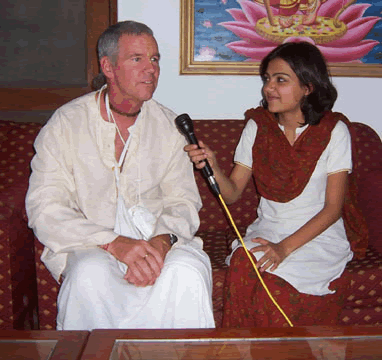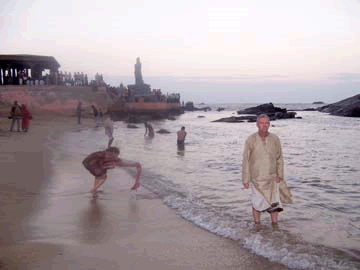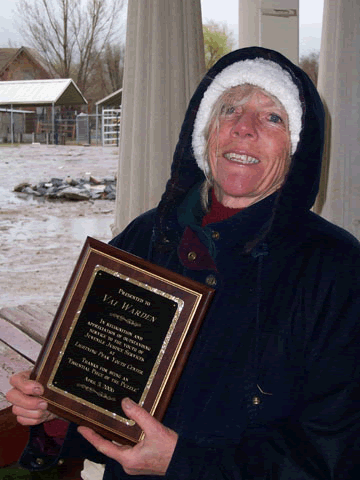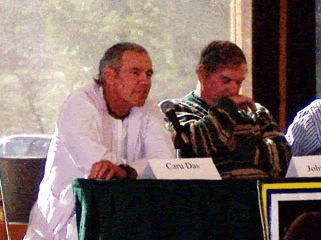The thesis of this paper will address one major question: Why would a Hare Krishna consider locating a temple in low density, rural area of Mormon-dominated Utah?
“Utah’s Krishna Pioneers”
by Chad Young
This piece was written for a history class at BYU in 1994
 Hinduism is one of the great religions of the world. Nearly all of India’s population of 900 million call themselves Hindus. Another 20 million Hindus live throughout the rest of the world.
Hinduism is one of the great religions of the world. Nearly all of India’s population of 900 million call themselves Hindus. Another 20 million Hindus live throughout the rest of the world.
The central texts of Hinduism are the Vedas, a treasury of spiritual laws and scripture. These Vedas are drawn upon by a majority of sects which fall under the heading of Hinduism. They give unity to a religion which is, in numerous ways, undefinable.
For many years, cultures of the western world sent and continue to send missionaries to India. When Swami Vivekananda arrived in Chicago for the World’s Congress of religions in 1894, a cross current of Hindu and Christian ideas began. Since 1894, various Hindu leaders such as Mohandas K Gandhi and A.C. Bhaktivedanta Swami Prabhupada have exposed the United States to Hindu religion and culture. In 1965, the founder of the most widely followed US Indian organization arrived in New York from Calcutta. AC Bhaktivedanta, at the age of 70, began the International Society for Krishna Consciousness (ISKCON) without financial or organizational backing. This group, known as the Hare Krishnas, spread to every continent.
 Central to the lifestyle of ISKCON devotees are vegetarianism and abstinence from illicit sex, intoxicants, and gambling. Incorporated temples are established in a number of US cities with high population densities. However, this historical essay focuses on some of the events which lead to the founding of an ISKCON Temple in unincorporated Utah County.
Central to the lifestyle of ISKCON devotees are vegetarianism and abstinence from illicit sex, intoxicants, and gambling. Incorporated temples are established in a number of US cities with high population densities. However, this historical essay focuses on some of the events which lead to the founding of an ISKCON Temple in unincorporated Utah County.
The thesis of this paper will address one major question: Why would a Hare Krishna consider locating a temple in low density, rural area of Mormon dominated Utah? The hypothesis is that the pre-Utah experiences and successes of the temple’s founder, Chris Warden, compelled and allowed him to locate in Utah County.
The length of this paper will only allow a portion of Mr. Warden’s life preceding his arrival in the Beehive State to be addressed. This segment of his life was critical in directing the path which eventually led him to pioneer the Hare Krishna movement in this region of the United States.
Before becoming Krishna Conscious Christopher Warden attended a private school during his high school years in New Jersey called Lawrenceville. He classified himself as an average honor student. He then attended the University of Virginia for 2 years. During college he became involved with the VISTA program (Volunteers in Service to America) which is a domestic version of the Peace Corps. After a 6 week training period in Baltimore, he received a one year assignment to serve with a partner in Atlanta. Shortly after Chris’ arrival, his partner’s year expired and he found himself the only Caucasian living in the ghetto of People’s Town. The members of that community adopted Chris as their token social worker and he became very comfortable working and living in that environment. The experience developed Chris interpersonal skills which served him once again as a minority in Mormon Utah.
After VISTA service in Georgia, Chris moved on but in a direction away from the university. The Vietnam War was then raging. In order to protest and avoid participation, Chris left the country. While outside of the US, he lived for 6 months in Paris, 12 months on an Israeli kibbutz, and traveled overland from Europe for a visit to India. In 1969 while traveling in Singapore, Chris met his future wife, Christine, who was also traveling extensively at the time. A month later the two of them arrived in Sydney, Australia, rented an apartment in Potts Point, and worked respectively as a construction worker and waitress. 
One day, while emerging from the subway, Chris saw a flash of orange out of the corner of his eye and turned to view a robed follower of Krishna Consciousness. The new and exotic sight fanned curiosity. The devotee shared a message that was reasonable and non-sectarian. He said that love of God is a dormant seed in the hearts of all and that the way to nourish that seed was through the chanting of God’s Holy Names. The theology proclaimed by this member of ISKCON seemed to have greater substance and value to Chris than other philosophies that he knew of.
For a period of 6 months, he and Christine visited the Sydney temple, while working to raise money to continue their travels. When the time came to depart, however, they were loathe to leave the ISKCON Society which offered so much to both of them. They stayed on, moved into the temple, and began in earnest their efforts to spread Krishna Consciousness to Australia. It was May of 1970 and they had found the meaning and drive that would define them for the rest of their lives.
 Soon after, the original two devotees who had brought Krishna Consciousness went one to Fiji and the other to Hong Kong to establish other centers. Chris was shocked when, on the way to the airport, they asked him, a neophyte, to be the new temple president.
Soon after, the original two devotees who had brought Krishna Consciousness went one to Fiji and the other to Hong Kong to establish other centers. Chris was shocked when, on the way to the airport, they asked him, a neophyte, to be the new temple president.
While serving as president he moved the temple from the suburbs to a store front in a trendy section of Sydney called Paddington. The location offered greater exposure and a more central location than the previous. While at this location, Prabhupada made his first visit to Australia bringing with him Deities for the temple. During his visit, Chris, now initiated as Caru das (servant of the most beautiful, God, and Christine was Vaibhavi Devi), discovered a propensity for working with the media. He was successful in gaining coverage for the saintly visit from all three national television stations as well as newspaper coverage. In subsequent years he used the media often to further Krishna Consciousness through broadcasts of events such as weddings, festivals, and other visits by Prabhupada. He also arranged many public speaking opportunities for his spiritual master. In these connections, he was himself interviewed many times on radio and television, and gave numerous high school and college lectures on Krishna Consciousness.
After 5 years in Australia, Caru (pronounced as Charu) returned to his native America in 1975. He was asked to join a traveling group of devotees who worked for the Bhaktivedanta Book Trust. The group of devotees, including Charu, traveled to university libraries and faculty nationwide, securing orders for Prabhupada’s books, translations of the Vedas into English with commentary. The record for the most orders per campus was 6 with both Dartmouth and Harvard reaching that number. Then two of the members of the BBT party arrived in Utah to visit Brigham Young University. They shattered the previous records at Dartmouth and Harvard by taking 19 orders within a two day period! News of these orders reached Charu and left a favorable impression of Utah upon him. He reasoned that the large number of sales on the BYU campus meant that the area must be three times more pious than any other area in the United States. That impression never did leave him, and eventually moved to the forefront of his mind when Utah surfaced in 1982 as a possible preaching area.
After working with the Bhaktivedanta Book Trust, Charu was asked to be temple president in San Francisco.  The temple building happened to be a former Mormon stake building and was located a mere 4 blocks from the University of California at Berkeley.
The temple building happened to be a former Mormon stake building and was located a mere 4 blocks from the University of California at Berkeley.
During his 3 year tenure at Berkeley, the number of devotees grew from 20 to 110. One important San Francisco event which the temple president was duty bound to maintain was the Festival of the Chariots held annually in Golden Gate Park. Prabhupada had started it there in 1968. Once again Charu used the media to advertise the event, putting up street banners, posters inside buses and in shop windows, and sending out press releases. Through those efforts attendance jumped from 2 to 3 thousand to more than 20,000, as reported in 1976 in a front page headline story of the San Francisco Chronicle. However, a flair for utilizing the media did not prevent the havoc wrought by the passing of A.C. Bhaktivedanta Swami Prabhupada in November of 1977.
The GBC (Governing Body Commission) directed the affairs of ISKCON after Prabhupada’s passing away and many devotees felt disenchantment and sometimes slighted by them. The GBC sent a guru (Hansadhutta) to act as a spiritual advisor. The initial understanding was that the operation of the temple (including finances) would remain the prerogative of Charu, the president. But this was so often unilaterally violated by the newcomer that the successes of the temple began to wane. The assets of the temple and population of devotees did not weather well. In the winter of 1978, Charu and his wife left the temple, never to return.
Three months later, Charu and his wife were asked by the GBC to join a younger devotee named Devi Deva in Toronto. Devi Deva had successfully petitioned the GBC to fund an assemblage of trucks, tents and exhibits to proclaim Krishna Consciousness at festivals nationwide. This festival party was first introduced in New York, where Devi Deva’s lightweight exhibits did not survive 30 mph winds. The first year’s festival party turned out to be a disaster. Charu hauled the broken exhibits to Los Angeles to regroup. Devi Deva stayed on the east coast.
The second attempt at the Festival of India then began anew with another devotee, Madhuha, rebuilding and reinforcing the exhibits. In 1980 the festival traveled to temples throughout the country during the summer months, for a successful season. Then, with an idea to utilize the resources year round at fairs and college campuses, Charu approached the GBC, and got permission to use this extra revenue to spread Krishna Consciousness according to his own discretion.
 Explanations of the exhibits from a scholarly perspective covered the originals and the Festival of India moved into a new off season market with its more secular packaging. Universities were approached, and offered the festival free of charge in exchange for the right to sell vegetarian food and Indian clothes in and around the exhibits and entertainment. A larger amount of exposure to the public and new associations came through the festival. Representatives from the many universities freely gave their praise for the exposition of Indian culture and recommended it to yet others. In the first 18 months of operation, with a lot of traveling and backbreaking work, the organization netted $120,00 profit. The ability to organize and operate this festival coupled with advertising savvy financially prepared Charu to begin a new project to spread Krishna Consciousness.
Explanations of the exhibits from a scholarly perspective covered the originals and the Festival of India moved into a new off season market with its more secular packaging. Universities were approached, and offered the festival free of charge in exchange for the right to sell vegetarian food and Indian clothes in and around the exhibits and entertainment. A larger amount of exposure to the public and new associations came through the festival. Representatives from the many universities freely gave their praise for the exposition of Indian culture and recommended it to yet others. In the first 18 months of operation, with a lot of traveling and backbreaking work, the organization netted $120,00 profit. The ability to organize and operate this festival coupled with advertising savvy financially prepared Charu to begin a new project to spread Krishna Consciousness.
During this same period, Charu produced a show for radio in the Los Angeles area called the Krishna Show It aired weekly on purchased time. His enjoyment of broadcasting and public speaking led him to look for other opportunities in the area. When the time came to invest profits from the traveling festivals, Charu looked at radio stations for sale in various parts of the country. After monitoring the classified ads in Broadcast Weekly for over a year, he finally came across an ad for a 1,000 watt AM station in the Provo area. The seed planted about Utah when he was part of the Book Trust propelled him to fly from Los Angeles to visit the site. The station’s highway access, and proximity to a university were highly appealing. The 5 1/2 acres of land that came along with the station and the beautiful surrounding mountain vistas were also selling points. Finally, the price at $130,000 (not including real estate) was less than 1/5 of what the average AM station sold for 1982.
 The stage had then been set. Charu had been the president of two ISKCON temples, operated a large traveling festival, spoken into microphones and on stage hundreds of times, produced radio shows, and also had some limited exposure to the Utah culture. He had money for a down payment, the ethic to produce more money as needed, the experience of establishing and running temples, and a respect for the Mormon lifestyle. Therefore, the pious and godly location available catered to his qualifications and specifications. A window of opportunity opened for Charu and His wife Vaibhavi, allowing them to jump through and become Utah’s Krishna Pioneers.
The stage had then been set. Charu had been the president of two ISKCON temples, operated a large traveling festival, spoken into microphones and on stage hundreds of times, produced radio shows, and also had some limited exposure to the Utah culture. He had money for a down payment, the ethic to produce more money as needed, the experience of establishing and running temples, and a respect for the Mormon lifestyle. Therefore, the pious and godly location available catered to his qualifications and specifications. A window of opportunity opened for Charu and His wife Vaibhavi, allowing them to jump through and become Utah’s Krishna Pioneers.
Click here for a great article on Utah.com about the construction of the temple.